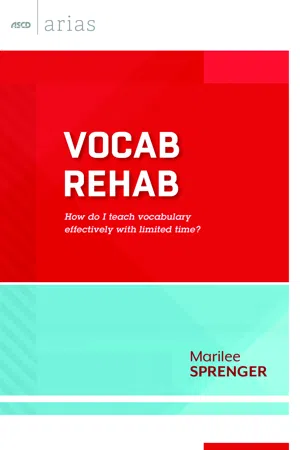![]()
The Value of Vocabulary
At reading time, Jesse tried to make himself as small as possible as he scrunched down in his seat. This was the worst part of the school day. Having escaped embarrassment yesterday, he knew Mrs. Sprenger would call on him today. How he wished he could make himself disappear.
It wasn’t that he hated books. In fact, he loved listening to his teacher read stories in different voices. His parents were always too busy or too tired from working all day to read to him and his sisters. When the class went to the library, Jesse loved to look at books about airplanes. Although he didn’t understand all of the words, he loved the pictures and hoped that someday he could be a pilot. He would be daydreaming right now about gliding through the air if he weren’t consumed by a fear of making mistakes if called upon to read.
Jesse moved his head so that the head of the student in front of him blocked Mrs. Sprenger’s view of him. Had he had the opportunity to read about ostriches, he would have known that the “head in the sand” technique was ludicrous (and perhaps he would know what the word ludicrous meant!). The disappearance of a face to gaze upon was a red flag to Mrs. Sprenger, from whom the dreaded phrase soon rang out: “Jesse, it is your turn to read.”
The words hung in the air for a few moments before Jesse realized that the inevitable had happened. His time had come. He rubbed his right hand anxiously up and down his thigh, as though this action would push the words out of his mouth. With his left hand, he held the book and searched for his portion of text. His eyes glazed over as he stared at the lengthy paragraph. The voice in his head panicked: “Run out of here,” it said, and, “Throw up—no, don’t throw up, that would be too embarrassing.” He cleared his throat and prepared for the worst.
Suddenly, Mrs. Sprenger spoke once more. “I saved this part for you, Jesse. I know you like airplanes.” As Jesse’s eyes scanned the paragraph, he hoped for something familiar. When he saw the word pilot, his brain responded with curiosity and a little relief. He began:
“The pilot was having a heart at-tack and even as the kk—the knowledge came to Brian he saw the pilot sl-sl-sl-am into the seat one more time, one more a-w-f-u-l time he sl-sl-am-med back into the seat and his rr-i-ght leg jumped, no jerked, pulling the plane to the side in a sud-den twist and his head fffell for-ward and spit (spit?) came.” Jesse wanted to know more about the spit and labored through the rest of the paragraph.
When he was done, he sat back waiting to hear what the next student would read. He liked this book!
Jesse’s lack of word knowledge might be partly attributed to a scarcity of reading in his home. The more children are read to and the more books they have available to them at home, the more likely it is that their vocabulary will increase (Wolfe & Nevills, 2009). There is a strong correlation between success in school (and even in life) and a robust vocabulary. By the time a child is 2 years old, he or she will have, on average, a vocabulary of between 100 and 200 words and will be able to form short phrases such as “mama sit” and “dada go” (Wolfe & Nevills, 2009). Between the ages of 2 and 3, as brain activity increases in the language areas, sentences can become longer and more complex; this period offers an incredible opportunity for increasing vocabulary through reading and speaking. By the time they reach 1st grade, most children have a vocabulary of about 6,000 words, and many add another 3,000 every year through 3rd grade (Sprenger, 2013).
The Three Tiers of Vocabulary Development
In their three-tiered model of vocabulary development, Beck, McKeown, and Kucan (2013) classify words as follows:
- Tier 1: These are the common, everyday words that most children enter school knowing already. Since we don’t need to teach these, this is a tier without tears!
- Tier 2: This tier consists of words that are used across the content areas and are important for students to know and understand. Included here are process words like analyze and evaluate that students will run into on many standardized tests and that are also used at the university level, in many careers, and in everyday life. We really want to get these words into students’ long-term memory.
- Tier 3: This tier consists of content-specific vocabulary—the words that are often defined in textbooks or glossaries. These words are important for imparting ideas during lessons and helping to build students’ background knowledge.
Direct Vocabulary Instruction
Think of your brain as a filing cabinet. If you create a file for each word you hear and continually add to it, the file will eventually be full of word information, and the cabinet drawer will become well-worn and easy to open. A word becomes a true addition to your vocabulary when it is easily accessible: the more information you have stored in a word’s file, the more useful the word becomes.
There are certain words that teachers need to make sure students add to their mental filing cabinets—specifically, those that don’t habitually show up in the texts that we read to our students or the books that they read for themselves. According to Marzano and Pickering (2005), we teach approximately 300 such words to our students through direct vocabulary instruction each year. Research has shown that students who receive direct vocabulary instruction in content-specific terms can raise their scores on comprehension tests from the 50th percentile rank to the 83rd (Stahl & Fairbanks, 1986).
Vocabulary Diversity
It all sounds pretty simple: students come to our classrooms with a certain number of vocabulary words, they gain more as they listen and learn through dialogue and reading, and we as teachers add a few more each week through direct instruction. We can do that; we have been doing that. So what’s the problem? Why are students having trouble with vocabulary on tests and in their speaking and writing? I believe the answer is “vocabulary diversity.”
Our classrooms are far more diverse—ethnically, linguistically, and socioeconomically—than they ever were in the past. In one oft-cited six-year study, researchers Todd Hart and Betty Risley (2003) compared the vocabularies of children from white-collar, blue-collar, and low-socioeconomic-status (low-SES) families. They found a huge discrepancy among the three groups in the number of words the children were exposed to at home—a finding that helps explain the discrepancy in the children’s vocabulary. Bracey (2006) reached the startling conclusion that children from middle- and upper-class families actually spoke more words than mothers from low-SES families. To further underline the discrepancy, the rate of vocabulary acquisition appears to be cumulative: children with larger vocabularies learn new words faster than those with more limited vocabularies (Hart & Risley, 2003).
The more words you know, the easier it is to draw connections with new ones—an important part of forming categories. As a student learns a new word, other words are attached to it. For example, the word airplane is linked to fly, which is related to eagle, which is related to birds, and so on; these words and others form the category of “things that fly” (Stahl & Stahl, 2012). A student who learns the word determine might store it alongside such related words as decide, define, conclude, and choose. Such simple categories of related words can serve as building blocks for more complex categories, thus helping to build cognitive skills. Synonyms, antonyms, and other relevant data are added to a word’s file as storage continues to grow, expanding over time as we hear the word take on different nuances in different contexts.
Vocabulary and Classroom Conversations
In our ever-changing world, we try our best to relate to our students. We pay attention to the music they listen to, the websites they visit, and the latest technology they’re using. Building rapport with students is an important part of helping them feel safe and welcome in the classroom. The presence of solid teacher-student rapport can contribute to academic success and motivation.
Teachers will often attempt to relate to students by conversing with them on their level, adopting many of their expressions and colloquialisms. However, research suggests that this approach is not particularly conducive to vocabulary growth. We need to “teach up” by using academic language rather than kid language. (Himmele & Himmele, 2009). Consider the following conversation between a teacher and her students:
Mrs. Wiggins: I want to keep talking about the Civil War. Who remembers the year the war began? Maria?
Maria: 1861. There are really icky pictures in the book of guys with blood all over them.
James: Yeah, but it was cool to see that there were so many dead!
Mrs. Wiggins: James, did those “cool” pictures give you any ideas about this war?
James: Those guys were kinda stupid. They didn’t fight good.
Mrs. Wiggins: Who was the President of the United States that these men were fighting for? Johanna?
Johanna: I would have been a nurse and put on those neat bandages. President Lincoln made those guys fight.
Mrs. Wiggins: Who remembers the President of the Confederate States? Keenan, do you remember that d...





